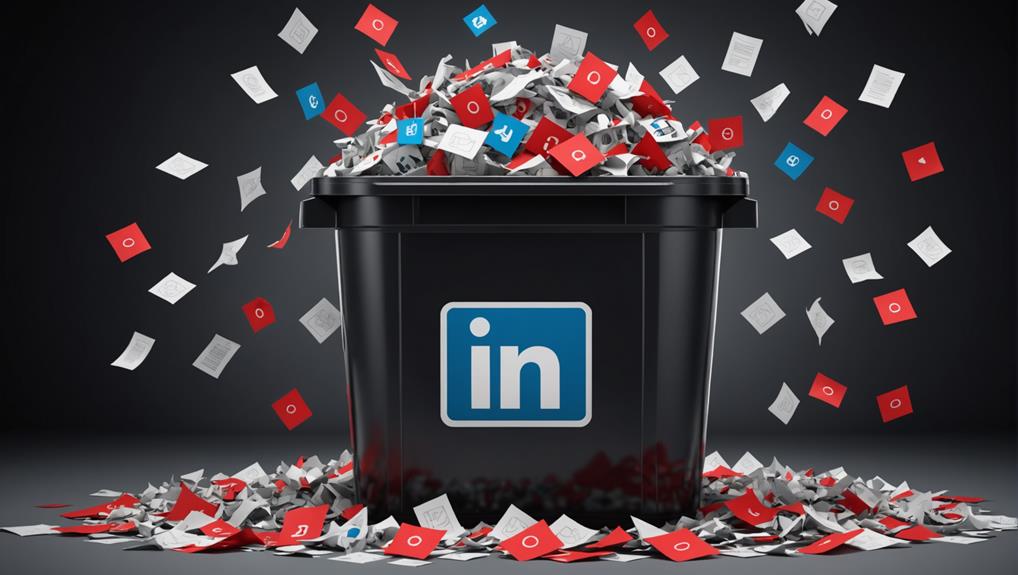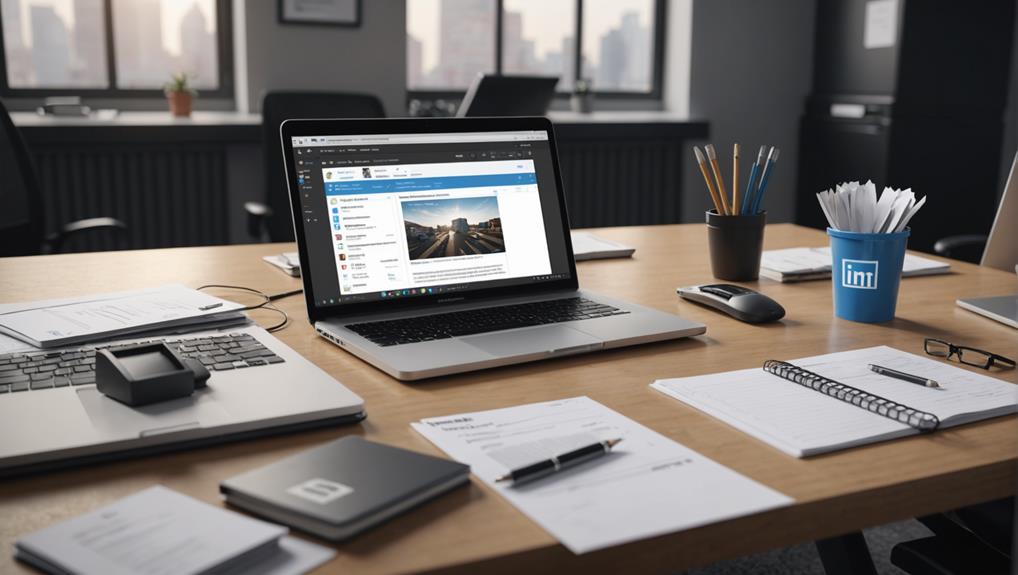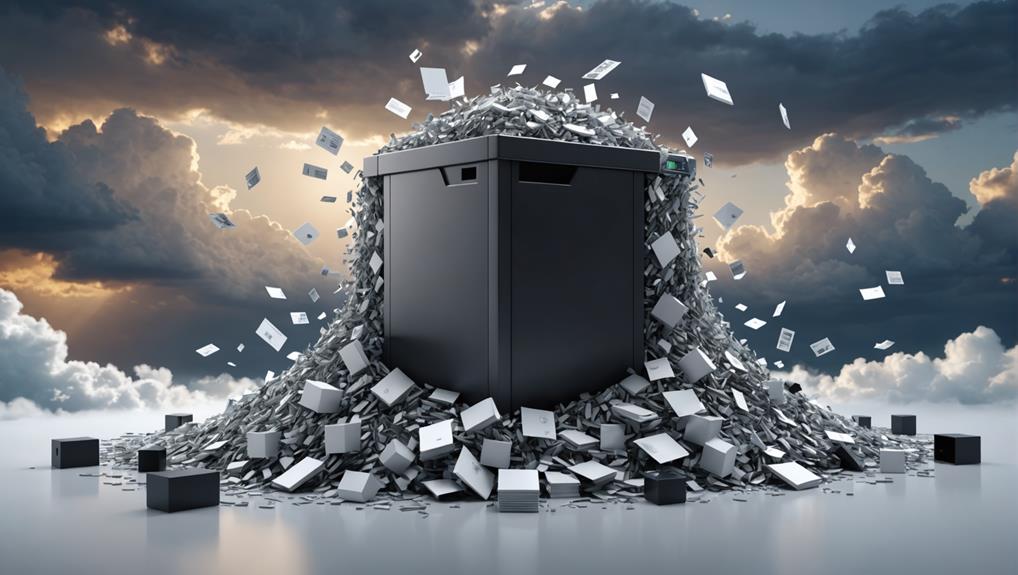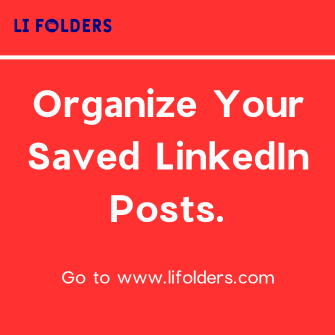
When you delete a LinkedIn message, it seems like it's gone, but it's not permanently removed from LinkedIn's servers. Your action affects everyone in the conversation; the message disappears from both your view and the recipient's inbox, yet it remains on a server to ensure network connectivity and compliance with legal standards. This process keeps your digital footprint tidier, allowing more control over your personal information and how you manage your professional interactions. There's more to discover about what happens behind the scenes to your messages and how this impacts your professional presence online.
Understanding LinkedIn's Deletion Process

When you delete a message on LinkedIn, it's removed from your inbox but not immediately erased from the platform's servers. You might think it's gone forever, but it's a bit more complicated than that. It's important to understand that, just like in a community, your actions on LinkedIn don't just affect you, they impact everyone connected to you. This interconnected environment means that your messages linger a bit longer, ensuring that you're not cut off abruptly from the network you belong to.
Imagine you're part of a vibrant neighborhood where every letter sent is kept in the local post office for a while, even after the recipient has read it. This is similar to how LinkedIn treats your messages. It's about keeping the lines of communication open and ensuring that everyone has time to process the interactions fully. This process speaks to the heart of why we all use LinkedIn—to foster and maintain professional connections. So, while your messages may disappear from your immediate view, they remain a part of the broader network for a bit longer, ensuring that no one feels left out or disconnected.
What Happens When You Delete?
Understanding how LinkedIn handles your deleted messages provides insight into what actually happens next. When you decide to delete a message, you're likely hoping it disappears completely, vanishing from LinkedIn's digital world as if it never existed. But it's not quite so straightforward. Initially, your action removes the message from your view and the recipient's inbox, creating a sense of privacy and control over your digital footprint.
However, while the message is no longer visible to you or the person you communicated with, it doesn't mean it's gone for good immediately. The deletion process involves several layers, ensuring that you feel part of a secure network where your actions have tangible effects. This initial deletion helps maintain a tidy communication space, enabling you to manage your interactions more effectively.
Data Retention Policies Explained

LinkedIn's data retention policies determine how long your deleted messages are stored before they're permanently removed from the servers. It's crucial for you to understand that when you're part of this platform, your data is treated with a level of care that aligns with both your need for privacy and the platform's legal obligations.
When you delete a message, it doesn't vanish immediately. Instead, it's stored for a specified period, which serves a dual purpose. First, it ensures that LinkedIn complies with legal data retention requirements. Second, it respects your possible need to retrieve information during unforeseen circumstances without compromising the overall integrity and privacy of your data.
You're not alone in wondering what happens behind the scenes. Many users feel more secure knowing that there's a predictable framework governing their online interactions. By being transparent about these processes, LinkedIn fosters a sense of trust and community. It reassures you that even in the digital realm, there are measures in place to protect your interactions and the professional relationships you build here. This approach not only upholds legal standards but also strengthens the bond between you and the platform.
Can Deleted Messages Be Recovered?
You might now wonder if there's a way to retrieve messages once they've been deleted from LinkedIn. The short answer is, it's not straightforward. Once you delete a message from your LinkedIn inbox, it disappears from your view immediately. However, this doesn't mean it's gone forever from all systems—there's a bit more to it.
When you're part of the LinkedIn community, you're not alone in wanting to occasionally pull up old communications, perhaps to reconnect with a contact or revisit a professional opportunity you discussed. Despite this common desire, LinkedIn's official stance is that once a message is deleted by a user, it cannot be retrieved through usual means available to you directly on the platform.
That said, there are indirect methods that might help. If you've emailed the conversation to yourself before deleting, check your email archives. Alternatively, the other person involved in the conversation might still have the messages and can share them with you.
Privacy Implications of Message Deletion

When you delete a message on LinkedIn, it's important to consider the privacy implications of how these messages are stored and potentially accessed by others. You're part of a broad community of professionals, and like you, everyone values their privacy and the security of their communications. It's essential to remember that deleting a message doesn't necessarily mean it's gone forever from every system.
This process impacts not just your own privacy but also that of the person you communicated with. For instance, if sensitive information was shared, even in a deleted conversation, there's a chance it could be exposed in ways you hadn't anticipated. You're not alone in this—many others share your concerns about personal and professional information potentially lingering online.
Moreover, while you might feel a sense of relief after hitting 'delete,' understanding the broader implications helps you and your network make more informed decisions about what to share in the first place. It strengthens the trust within your professional circle when everyone is aware and respectful of how data might be treated. After all, you're all in this together, navigating the complex world of digital communication and privacy.
How LinkedIn Handles Server Data
Understanding how your data is managed on LinkedIn's servers can give you clearer insights into the lifetime of your messages after deletion. When you're part of LinkedIn, you're not just using a platform; you're entrusting it with bits of your professional life. It's crucial to feel secure and included in the community, knowing exactly where and how your information is handled.
Once you delete a message on LinkedIn, it doesn't immediately vanish from existence. Instead, it's marked for deletion in the active user interface, but it remains on LinkedIn's servers for a short period. This retention ensures that in cases of accidental deletions, your information can be recovered swiftly, keeping you connected without missing a beat.
LinkedIn employs robust server management practices to safeguard your data. They use multiple layers of security, including encryption, to protect data from unauthorized access. Moreover, their data centers are equipped with advanced technologies to handle data efficiently and securely.
You're part of a network that values your presence and goes the extra mile to keep your professional interactions safe. Remember, your contributions and interactions create the rich tapestry that is LinkedIn, supported by a backend committed to your data's integrity and security.
Tips for Managing LinkedIn Messages

Keeping your LinkedIn messages organized can significantly streamline your professional communications. When your inbox is tidy, you're not just keeping track of conversations; you're nurturing your professional network. You're part of a community where every message counts towards building lasting relationships and opening doors to new opportunities.
To start, regularly archive conversations that are no longer active but are important enough to save. This helps de-clutter your main inbox while ensuring you can always revisit old discussions when needed. It's like keeping a file of business cards you might one day need to tap into.
Don't forget to utilize LinkedIn's tagging and search functionalities. Tagging helps categorize messages, making them easier to retrieve. Whether it's 'pending projects', 'networking', or 'job offers', tags can help you sort and prioritize at a glance. Moreover, searching by keywords can save you from scrolling through endless messages, allowing you to focus on what's truly relevant.
Lastly, make it a habit to regularly clean up your inbox. Set a monthly reminder to review messages and clear out those that no longer serve a purpose. By doing so, you keep your digital space welcoming and manageable, inviting new connections and opportunities into your professional circle.
The Impact on Your Digital Footprint
Every LinkedIn message you send or receive contributes to your digital footprint, shaping how others perceive your professional persona. It's crucial to remember that your online interactions can linger in the digital world. You're not just chatting; you're building a visible legacy that reflects your professionalism and values.
Think of your LinkedIn inbox as more than a tool for networking; it's a space where you curate your professional identity. Each message is a brushstroke in the portrait you're painting of yourself to colleagues, potential employers, and industry peers. It's about more than just the words you type; it's about the connections you foster and the community you build around your career.
When you interact thoughtfully, you're inviting others into your professional circle, creating opportunities for collaboration and growth. Conversely, a poorly thought-out message can alienate and create barriers. Be mindful of the content and tone of your messages—they're all pieces of a puzzle that, when pieced together, tell the comprehensive story of your professional life.
Your digital interactions are a mirror of your professional ethos. Engage with intent, respect, and authenticity, ensuring that your digital footprint steadfastly represents the best of your professional self.
Future Changes in Data Handling

As technology evolves, you'll need to stay alert to how platforms like LinkedIn handle your data. It's not just about keeping up with changes; it's about being part of a community that values privacy and transparency. Soon, you might see more user-friendly settings that let you control who sees what, ensuring that you're not left out of key decisions about your personal information.
Imagine a future where LinkedIn introduces dynamic consent features. You'll be invited to engage with settings that adapt to both global privacy trends and your personal preferences. This inclusivity isn't just beneficial for you; it fosters a sense of collective security and trust within the network, making everyone feel more connected and protected.
You're likely to witness increased transparency about data usage. LinkedIn could provide clearer, more detailed explanations of where your data goes and how it's used, directly in your settings menu. This isn't just reassuring—it's empowering. It allows you to make informed choices, ensuring that you're an integral part of the LinkedIn community, actively shaping its values and standards in data handling. So, keep your eyes open and be ready to adapt. After all, you're the cornerstone of this evolving digital landscape.
Conclusion
You've seen how LinkedIn handles deleted messages and the implications it has on your privacy. Remember, once you delete a message, it's typically gone for good, unless saved in backups for limited periods. Always think before you hit delete, as it affects your digital footprint. Stay tuned for any future updates on LinkedIn's data handling practices to ensure you're always in the know and managing your messages wisely to protect your professional interactions.






